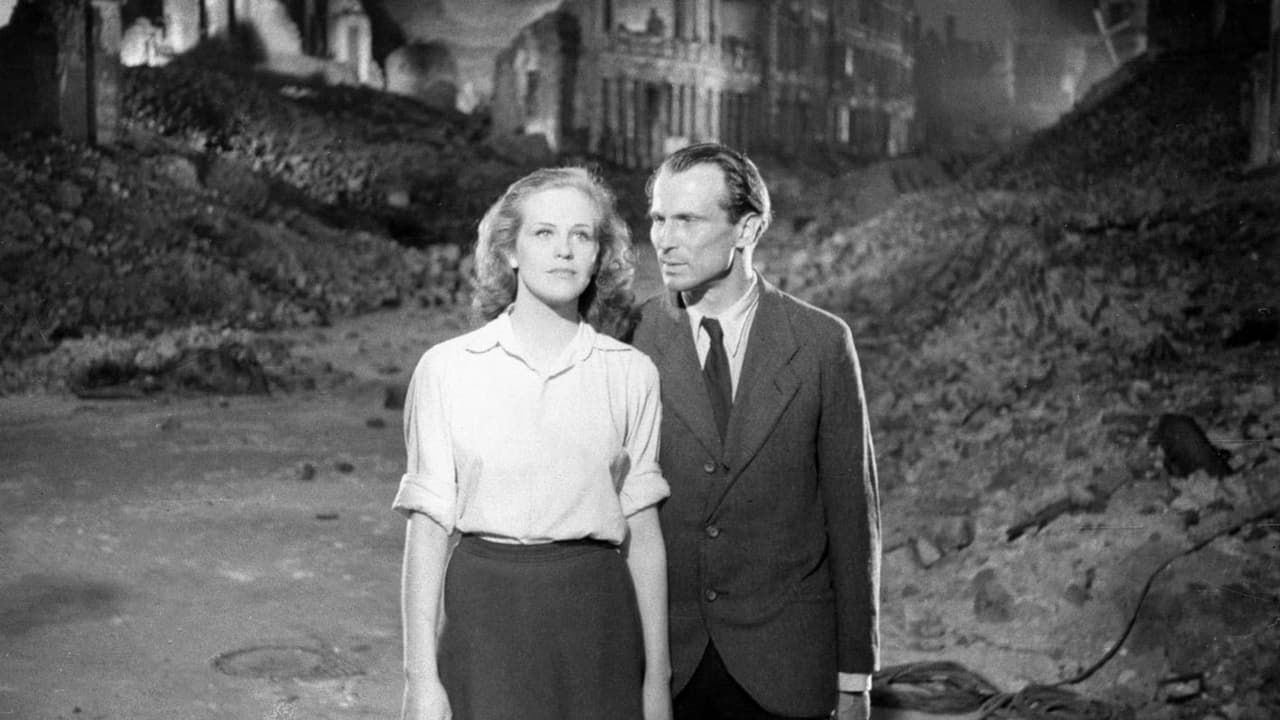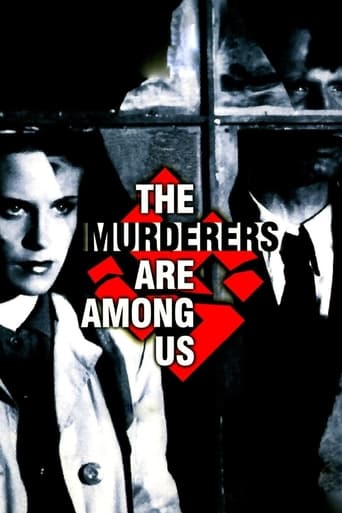Dartherer
I really don't get the hype.
Beystiman
It's fun, it's light, [but] it has a hard time when its tries to get heavy.
StyleSk8r
At first rather annoying in its heavy emphasis on reenactments, this movie ultimately proves fascinating, simply because the complicated, highly dramatic tale it tells still almost defies belief.
Scotty Burke
It is interesting even when nothing much happens, which is for most of its 3-hour running time. Read full review
jaredmobarak
Die Mörder sind unter uns is quite the tale, moreso for when the film was made then the actual subject matter itself. Wolfgang Staudte crafted his story to be released in 1946, just a year after World War II had ended. The effects of war and especially the atrocities that occurred in German concentration camps was still very fresh in the minds of survivors and soldiers alike. This film could have been completely polarizing, starting an uprising against those that partook in the Holocaust to acquire revenge. In fact, the original ending was supposed to show one such example of that retribution in blood, but the producers deemed it too powerful and didn't want the responsibility of creating a mob willing to do it for real. The ending that is used instead, one of discovering that revenge will only make your suffering worse—exacerbating the feelings of hopelessness by making one's self a killer as well—works more effectively in my mind because of its psychological underpinnings. How that conclusion is handled is another story, but not one without precedence in the movie. It is tacked on and orchestrated so cleanly and quickly that you just don't believe a word of it. But that is how the entire story plays out, one that is effective emotionally while lacking a lot structurally.I will grant the filmmakers the benefit of the doubt because they weren't out to get a character study out to the public, they wanted to show the effects of war and how Germany would need to forever live amongst those that killed without remorse for years under Hitler's regime. As a result, the characters are well fleshed out individually with all their problems and idiosyncrasies, but their relationships with each other are stilted and false. How some people know one another can never be explained in certain instances and the fast track comradery between others comes from nowhere at times. Take our two leads, Dr. Mertens, (the man who has taken up residence at a former prisoner's old apartment), and Susanne Wallner, (that returned prisoner looking for home). When she comes back it is with the mindset of residing there again, it was hers. She is not overly possessive as she tells Mertens he may stay until he finds another place, but he will have none of it. This has been his home and since the war ended he has not fully recovered from the Stockholm Syndrome ruling his life. A doctor that can no longer stomach the sight of blood after what he witnessed in the Nazi army, Mertens has found solace in the drink, completely drunk at most times of the day in order to silence the sounds and screams of just a few months previous. So, we go from the two living in separate rooms never to intrude on the other, to he enjoying having a woman around to cook and clean, to the two of them being madly in love with each other. Sure it was a foregone conclusion, but there is no courtship at all, we are just meant to believe it happened behind the scenes.Now, by having those relationship points glossed over does allow for more time to delve into the meat of the tale. You see, Mertens was a doctor under the command of Captain Brueckner, a man responsible for the deaths of innocent women and children despite his pleas for leniency. Only when the doctor sees his Captain in a field, apparently dying, does he believe the nightmare might be over, God has gotten retribution for him; he will not have to shed blood himself to make up for the loss of those in the camp. In the great coincidental way that movies always seem to possess, the Captain's death is discovered to have been untrue by Susanne, after she finds a letter to his wife amongst Mertens' things. She takes it upon herself to deliver this letter, only finding that Brueckner survived and would love to see the doctor again for he was a steady and reliable comrade. This discovery only drags Mertens down deeper and deeper into his drowning soul, doing whatever he can to stay afloat, only to find that murder of the murderer can be the only way.The film's style reminded me a lot of Sergei Eisenstein's Battleship Potemkin in its use of montage and transitions. Maybe it was just the stark black and whites and the use of shadow and sharp cuts, but being only 20 years later, in an obliterated nation, I don't think one has to go too far to understand a Russian influence here, especially since they backed the financing. Oftentimes there are some stunning visuals on display too. The use of looming shadows encompassing characters like that at the end or close-ups to portray emotion is effectively handled. What a unique way to express flashback by showing only Borchert's face as his Mertens remembers the killings at the camp. His eyes opened wide, we can only see into his soul while the sounds superimposed express the atrocity he witnessed.But I also enjoyed the small details of the time period and the authenticity of it all. My friend who showed me the film believes it was shot in Berlin with the real rubble surrounding them as a set. I wouldn't be surprised if she was correct, because it all felt real and was lingered upon often. A favorite character of mind supposedly showed an occupation of the time also, of a psychic/seer. The Lenin-esquire actor performed a service to Herr Mondschein, a man waiting desperately to see his son return home. It is a job to instill hope while also cashing in on the suffering of the weak. An interesting moral compass changer that while nefarious does indeed perform a necessary service.
mdm-11
This powerful piece of Historic Fiction shows a realistic look at Post-WWII Germany, and the determination of the shook-up nation to pick up the pieces and survive their darkest chapter in modern history. Many gripping moments include the "return" of a young woman (played by a very young Hildegard Knef) who had spent years in Nazi concentration camps. Her innocence and purity are reflected in the woman's complete willingness to "forgive and forget" the attrocities witnessed and experienced.A main character was a commanding officer responsible for horrible acts against innocent civilians, while another had refused to take part in such evil. The final scenes "drive home" the message how some feel no remorse for their evil deeds, while others remain plagued with the images of those mercilessly tortured and murdered. Seeing the young woman who had been victimized by the evil regime step in to prevent a altercation between the man she loves and the man responsible for much of the suffering shows that humans are capable of forgiving and thus surviving into a better life, free of hate and vengeance.I highly recommend the original German version with or without the subtitles. Many of the effects require the original sound track. This would be a valuable teaching tool for an advanced German class, or a related European History lesson
dbdumonteil
"Die mörder sind unter uns" takes place in Berlin in ruins and features three main characters:Susanne (Hildegarde Knef),a survivor from the concentration camps;a former army medical officer,haunted and tormented by what he did and saw;a former nazi officer who feels no remorse because "he used to obey".Susanne ,played by gorgeous Knef,wants to pick up the pieces.She's the strongest character of the movie .She comes back from hell,so what could be worse?To her Xmas means forgiveness and she knows that death breeds death.When he sees her take care of the seedy flat,the doctor first shrugs,but soon he will use his radiographs to replace the panes. Biggest flaw:it's impossible to believe that Susanne is just out of a camp:actually she seems to go out of a beauty parlor.The doctor is a human wreck who heavily drinks to forget the war horrors.It's only when he meets again his former superior that he rouses himself from his lethargy.Although he feels hatred and thirst of revenge,he is not devoid of compassion:when he takes the man he wants to kill to a desert place among the ruins ,he heeds the call of a desperate mother:it's the most emotional sequence of the movie.On the other hand,the officer behaves as if the war had never happened:the parallel between the two Xmas celebrations(past and present) climaxes the movie .The director chose a good-natured actor,nothing like the nazi villain we generally meet.The directing shows Fritz Lang's (and expressionism) influence:the huge shadow on the criminal recalls the little girl with the balloon scene in "M".And along with "the third man",the movie had a strong influence on two movies: -"the man between"(1953),another Carol Reed movie :James Mason's character resembles the doctor of this movie.-and mainly,mainly, Rosselini's "Germania anno zero"(1948),which dwarves "die mörder sind unter uns".People who enjoyed Staudte's movie should see the Italian genius's masterpiece.
theorbys
Murderers Among Us is the first film made, of a vast trove of films, in the Soviet controlled sector of post-war Germany that was to become East Germany. It is deeply and masterfully immersed in the aesthetic traditions of German Expressionism and /or Film Noir: unusual angles and picture planes, extreme lighting effects, twisted stairs, bombed-out buildings that look like jagged fingers against the sky (it was shot in the ruins of Berlin), a haunted, tormented protagonist, stark black and white atmosphere, and, above all, shadows. Shadows and more shadows of every size, shape, and density. In fact this film could serve as a text book on shadow craft: the scene where a man is screaming from within the vast shadow of a pistol wielding attacker is magnificent. I haven't seen The Third Man recently but I am sure Murderers influenced it profoundly. I would recommend the Third Man as a good double feature with this film.Murders belongs to a genre called 'rubble films', shot in the rubble of Germany and frequently dealing with issues of German guilt after WW II. Murderers does not seek to deal overmuch with the people who gave the orders, but with the many Germans who followed them with little or no protest. Such as the wounded doctor in this film who stood by while even children were executed as reprisals against resistance fighters in occupied Poland. Plotwise the film works quite nicely, and I liked the atmosphere of renewal, and perhaps relief at the end of a nightmare, amongst all that ruin and rubble as the German people began to pick themselves up.

